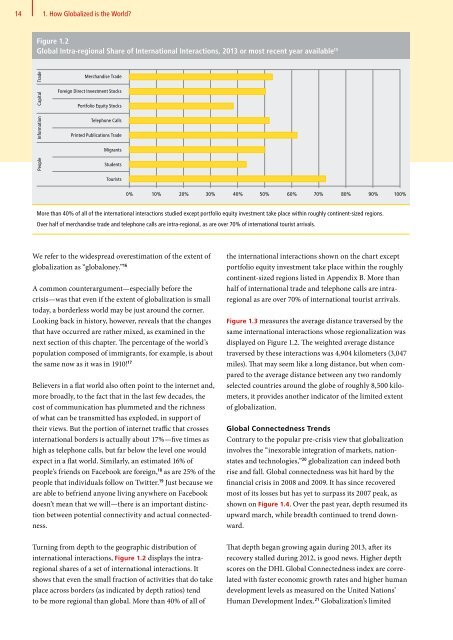DHL Global Connectedness Index 2014
DHL Global Connectedness Index 2014
DHL Global Connectedness Index 2014
- No tags were found...
You also want an ePaper? Increase the reach of your titles
YUMPU automatically turns print PDFs into web optimized ePapers that Google loves.
14 1. How <strong>Global</strong>ized is the World<br />
Figure 1.2<br />
<strong>Global</strong> Intra-regional Share of International Interactions, 2013 or most recent year available 15<br />
Trade<br />
Capital<br />
Information<br />
Merchandise Trade<br />
Foreign Direct Investment Stocks<br />
Portfolio Equity Stocks<br />
Telephone Calls<br />
Printed Publications Trade<br />
Migrants<br />
People<br />
Students<br />
Tourists<br />
0% 10% 20% 30% 40% 50% 60% 70% 80% 90%100%<br />
More than 40% of all of the international interactions studied except portfolio equity investment take place within roughly continent-sized regions.<br />
Over half of merchandise trade and telephone calls are intra-regional, as are over 70% of international tourist arrivals.<br />
We refer to the widespread overestimation of the extent of<br />
16 15<br />
globalization as “globaloney.”<br />
A common counterargument—especially before the<br />
crisis—was that even if the extent of globalization is small<br />
today, a borderless world may be just around the corner.<br />
Looking back in history, however, reveals that the changes<br />
that have occurred are rather mixed, as examined in the<br />
next section of this chapter. The percentage of the world’s<br />
population composed of immigrants, for example, is about<br />
the same now as it was in 1910! 17<br />
Believers in a flat world also often point to the internet and,<br />
more broadly, to the fact that in the last few decades, the<br />
cost of communication has plummeted and the richness<br />
of what can be transmitted has exploded, in support of<br />
their views. But the portion of internet traffic that crosses<br />
international borders is actually about 17%—five times as<br />
high as telephone calls, but far below the level one would<br />
expect in a flat world. Similarly, an estimated 16% of<br />
people’s friends on Facebook are foreign, 18 as are 25% of the<br />
people that individuals follow on Twitter. 19 Just because we<br />
are able to befriend anyone living anywhere on Facebook<br />
doesn’t mean that we will—there is an important distinction<br />
between potential connectivity and actual connectedness.<br />
Turning from depth to the geographic distribution of<br />
international interactions, Figure 1.2 displays the intraregional<br />
shares of a set of international interactions. It<br />
shows that even the small fraction of activities that do take<br />
place across borders (as indicated by depth ratios) tend<br />
to be more regional than global. More than 40% of all of<br />
the international interactions shown on the chart except<br />
portfolio equity investment take place within the roughly<br />
continent-sized regions listed in Appendix B. More than<br />
half of international trade and telephone calls are intraregional<br />
as are over 70% of international tourist arrivals.<br />
Figure 1.3 measures the average distance traversed by the<br />
same international interactions whose regionalization was<br />
displayed on Figure 1.2. The weighted average distance<br />
traversed by these interactions was 4,904 kilometers (3,047<br />
miles). That may seem like a long distance, but when compared<br />
to the average distance between any two randomly<br />
selected countries around the globe of roughly 8,500 kilometers,<br />
it provides another indicator of the limited extent<br />
of globalization.<br />
<strong>Global</strong> <strong>Connectedness</strong> Trends<br />
Contrary to the popular pre-crisis view that globalization<br />
involves the “inexorable integration of markets, nationstates<br />
and technologies,” 20 globalization can indeed both<br />
rise and fall. <strong>Global</strong> connectedness was hit hard by the<br />
financial crisis in 2008 and 2009. It has since recovered<br />
most of its losses but has yet to surpass its 2007 peak, as<br />
shown on Figure 1.4. Over the past year, depth resumed its<br />
upward march, while breadth continued to trend downward.<br />
That depth began growing again during 2013, after its<br />
recovery stalled during 2012, is good news. Higher depth<br />
scores on the <strong>DHL</strong> <strong>Global</strong> <strong>Connectedness</strong> index are correlated<br />
with faster economic growth rates and higher human<br />
development levels as measured on the United Nations’<br />
Human Development <strong>Index</strong>. 21 <strong>Global</strong>ization’s limited





